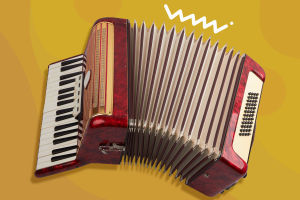Africans perform various ceremonies at birth, adulthood, marriage, childbirth, and death, and these ceremonies are of course inseparable from music and dance. In Africa, all objects and means that can provide sound, in a specific environment, can be used to create music.
In terms of shape, African musical instruments are extremely diverse and simple, and most of them are made of raw materials that nature can provide. Such as wood blocks, reed poles, horsehair, animal skins, ivory, animal horns, casings, gourds, coconut shells, clay, and wooden materials imitated by local craftsmen.
Although the production materials are simple and are directly taken from nature, Africans are not willing to be plain in the design of musical instruments and must be carefully crafted and manufactured. Below are some traditional musical instruments in Africa.
1. Djembe
Djembe is an important membrane musical instrument in Africa. It is said that it was invented and manufactured by blacksmiths of Mandin society in West Africa (Guinea, Senegal, Cote d'Ivoire, etc.). The shape of its drum body is derived from the mortar used by traditional tribes to smash grains. It is shaped like a trophy and has open ends at both ends.
It is traditionally made from the wood of the Link tree, which is very hard. Wrap the big end with the thickest piece of hide on the goat's back, scrape off the wool, and taut the hide through the hoops and ropes. Hit different parts of the drum head with the palms of both hands to obtain a rhythmic combination of high-mid bass.
Drummers can sit comfortably during performances, leaning the drum slightly forward, exposing the bottom bell to resonate. It can also be slung over the shoulder with the strap, which makes it easy to add fun performance moves while drumming.
The Djembe can either strike a steady rhythm or slap a dazzling solo, play in the form of a drum ensemble or as an accompaniment to a song, and is a versatile rhythm instrument.
2. Dundun
Dundun is an important drum instrument in the West African Mandin Drum Ensemble. Dundun is also generally made of Linkwood.
It is made by selecting tree trunks of three sizes, large, medium, and small, hollowing out the middle into a cylindrical shape, covering the openings at both ends of the cylindrical shape with thick cowhide, and tightening it with ropes to retain the hair on the surface of the cowhide.
The Dundun group is divided into kenkeni, sangban, and dununba, and the name of each drum is actually a simulation of the sound they make while playing. During the performance, the drummer hits the drum head with a drum stick with his right hand and hits a small iron bell (kenken) attached to the drum with his left hand with a metal ring.
The kenkeni is the treble drum, the sangban is the alto drum, and the dununba is the bass drum. When playing, the rhythms of the three drums are closely intertwined with each other.
3. Bara
Bara is a hand drum instrument that originated in the Segou district of Mali. The diameter of the drum head is about 60 cm, and sometimes larger. The drum body is made of wood, the drum head is made of calfskin, and the leather strips cut from the cowhide are used instead of ropes to tighten the drum head.
The Bara hangs from the drummer's waist when playing, or can be placed on the floor. The rhythm is produced by the drummer hitting the head with the palm of his hand. Bara is generally present at all festivals or celebrations in West Africa, especially in the bondialan region.
4. Tamani
Tamani is a traditional drum instrument in Mali. Tamani's drum is made of wood, in the shape of an hourglass, with two goat skins stretched on iron rings at both ends and fastened with elastic leather cords. When playing, the drummer hits the head of the drum with a curved stick and holds the drum around the waist with his big arm.
The tension of the leather rope is affected by the clamping force under the armpit, thereby changing the tension of the drum head to achieve the change of the timbre.
This ancient instrument is very familiar to all classes of society in West Africa, as in the past it was often used to inform tribal meetings. Tamani is also known as the "talking drum" because its sliding sound is very similar to the pronunciation of some African languages when it is played.


